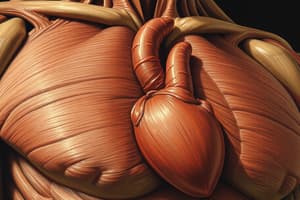Podcast
Questions and Answers
How much of a person’s body weight is taken up by skeletal muscle in males?
How much of a person’s body weight is taken up by skeletal muscle in males?
- 20-30
- 30-40
- 40-50 (correct)
- 35-45
- 25-35
Cardiac muscle is found only in the heart.
Cardiac muscle is found only in the heart.
True (A)
Smooth muscle is under voluntary control.
Smooth muscle is under voluntary control.
False (B)
What are the three types of muscle tissue?
What are the three types of muscle tissue?
What is the primary function of skeletal muscle?
What is the primary function of skeletal muscle?
Skeletal muscle is ______ muscle under conscious control.
Skeletal muscle is ______ muscle under conscious control.
Cardiac muscle cells are interconnected by ______ discs.
Cardiac muscle cells are interconnected by ______ discs.
What is the function of smooth muscle?
What is the function of smooth muscle?
Match the muscle type with its characteristic:
Match the muscle type with its characteristic:
What percentage of body mass does skeletal muscle represent?
What percentage of body mass does skeletal muscle represent?
Flashcards are hidden until you start studying
Study Notes
Overview of Muscle Tissue
- There are three types of muscle tissue: skeletal, cardiac, and smooth
- All muscle cells are elongated and referred to as muscle fibers.
- Muscle contraction depends on two types of myofilaments: actin and myosin.
- The prefixes myo, mys, and sarco all reference muscle.
Skeletal Muscle Tissue
- Skeletal muscle appears as distinct muscles that attach to the skeletal system.
- It has obvious striations.
- It is under conscious control (voluntary muscle).
- Skeletal muscle cells run the full length of a muscle.
- It is multicellular.
Cardiac Muscle Tissue
- Cardiac muscle occurs only in the heart.
- It is striated, but involuntary.
- Cardiac fibers are short, fat, branched, and interconnected.
- Cardiac muscle cells are interlocked by intercalated discs, and function as a single unit.
Smooth Muscle Tissue
- It is found in the walls of hollow organs such as the stomach, urinary bladder, and intestines.
- It has no striations.
- It is not subject to voluntary control.
Differences in Contractions
- Skeletal muscle can contract rapidly but tires easily and must be rested.
- Skeletal muscle contractions vary in force depending on use.
- Cardiac muscle contracts at a steady rate but can accelerate to cope with demand.
- Smooth muscle contracts in steady, sustained contractions and continues tirelessly.
Muscle Functions
- Muscle performs four important functions in the body: producing movement, maintaining posture, stabilizing joints, and generating heat.
Producing Movement
- Movement results from muscle contraction.
- Skeletal muscles are responsible for all locomotion and manipulation.
- Skeletal muscles control eye movement, facial expression, circulation, and the movement of gas, liquids, and solids throughout organs.
Maintaining Posture
- Skeletal muscles are constantly utilized to maintain sitting, standing, and moving postures.
- Postural muscles develop to compensate for the never-ending pull of gravity.
- The curves of the spinal column are shaped by the interplay of skeletal muscle and gravity.
Stabilizing Joints
- Skeletal muscles provide the dynamic stability of joints.
- Many joints are poorly reinforced by ligaments and connective tissue.
- Many joints have noncomplementary surfaces, which do not contribute to stability.
Generating Heat
- Muscles generate heat as they contract.
- The heat generated is vitally important to maintain normal body temperature.
- Skeletal muscle generates most of the heat as it represents 40% of the body mass.
- Excess heat must be released to maintain body temperature.
Functional Characteristics
- Excitability or irritability: The ability to respond to a stimulus.
- Contractility: The ability to shorten forcibly.
- Extensibility: Muscle fibers can be stretched.
- Elasticity: The ability of muscle to resume its normal length after being shortened.
Q&A
- The question is about the portion of body weight made up by skeletal muscle.
- The question has multiple choice answers, but only the answer for males is given.
- Answer: For male: 40-50%
Studying That Suits You
Use AI to generate personalized quizzes and flashcards to suit your learning preferences.



